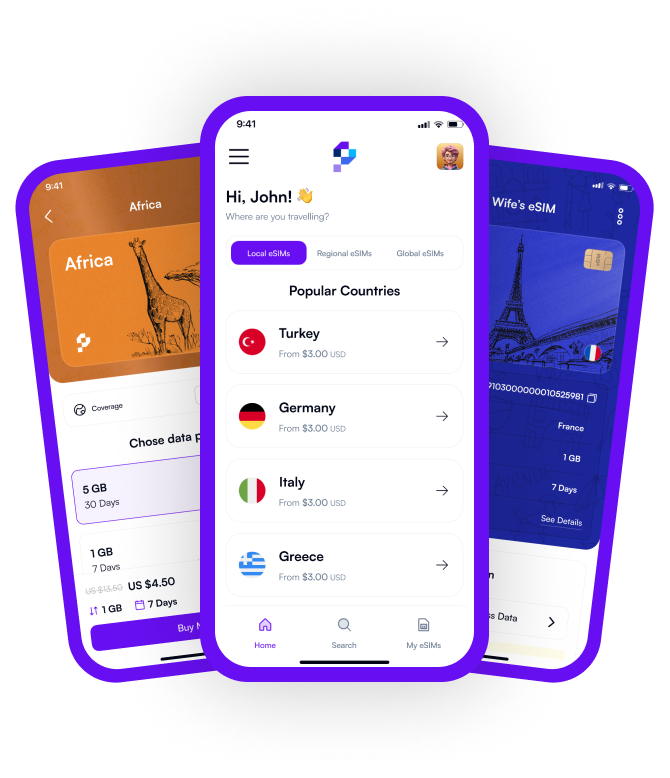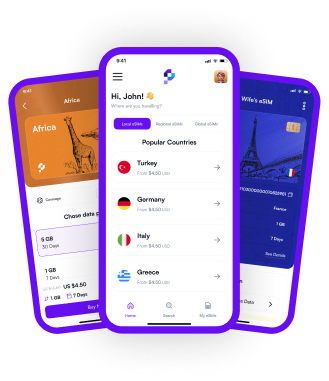iPads, with their high performance, large screens, and portability, have become an ideal mobile device for many users. Especially for those who are constantly on the move for travel or work, an internet connection is essential. At this point, two main options come up for mobile connectivity: eSIMs and physical SIM cards. So, which option is more advantageous for iPad users? In this blog post, we will thoroughly examine what you need to know about eSIMs and SIM cards on iPads.
What is an eSIM and How Does It Work on an iPad?
eSIM (embedded SIM) is a digital SIM technology that allows you to connect to a mobile network on your iPad without the need for a physical SIM card. Instead of the traditional SIM card, it operates on a chip integrated into the iPad's hardware. This means you can load mobile data plans from different operators without having to change a physical SIM card, and you can connect to the internet instantly.
Advantages of Using eSIM on iPads:
- Easy activation: eSIM can be quickly activated by scanning a QR code or through an app. It is especially practical when traveling or in urgent need of a data plan.
- No need for physical handling: Since there is no physical card, there is no risk of it getting lost or damaged.
- Multiple profile management: With eSIM, you can load multiple mobile operator profiles. This is a significant advantage for those traveling to multiple countries, as you can easily use local data plans for different countries.
You can check the compatibility of iPads with eSIM technology by visiting the Compatibility page. Compatibility may vary depending on the model of the iPad and the region you are in.
What is a Physical SIM Card and How Common is It?
A physical SIM card is a traditional plastic card used in mobile phones and tablets to establish a mobile data connection. It has been the standard method for configuring a mobile data line on iPads for many years, and many users still prefer this method.
Advantages of Physical SIM Cards:
- Network coverage: Many mobile operators offer very wide coverage areas with physical SIM cards, and these cards are compatible with almost all mobile devices.
- Ease of switching: SIM cards can be easily inserted and removed, allowing them to be used in different devices.
However, there are some disadvantages to physical SIM cards:
- Portability issues: Due to their small size, they can be easily lost, and you may need to carry a spare SIM card.
- Limited convenience: Replacing a physical card can be time-consuming and challenging, especially when traveling. Also, purchasing a new SIM card in each country can be both costly and impractical.
The Rising Popularity of eSIMs in iPads
As mobile devices continue to digitalize, eSIM technology is becoming increasingly popular. Apple is making eSIM support a standard in its new generation iPads. This means many users can now quickly connect to the internet using eSIM without needing a physical SIM card.
eSIM provides great convenience, especially for users who frequently travel internationally. Without the hassle of searching for a local SIM card in different countries, you can purchase a data plan through an eSIM provider and activate it instantly. Pocket eSIM offers a great solution for this. You can check which iPad models are compatible with eSIM technology by reviewing the Compatibility page.
Differences Between eSIM and SIM Card
1. Physical Structure
- eSIM: There is no physical card; it is digital and embedded inside the device.
- SIM Card: A small plastic card inserted into the device.
2. Ease of Use
- eSIM: Adding a new operator profile requires no physical intervention. It can be activated within a few steps by scanning a QR code or via an app.
- SIM Card: For every new operator, the SIM card must be physically replaced.
3. Portability
- eSIM: Since there is no physical card, there is no risk of it being lost or damaged.
- SIM Card: Due to its small size, it can easily get lost or broken.
4. Multiple Line Usage
- eSIM: You can use multiple mobile data profiles on the same device, a great advantage for travelers.
- SIM Card: Generally, only one SIM card can be used in a device. Dual-SIM devices are required for multiple lines.
5. Activation Time
- eSIM: Can be activated instantly within minutes.
- SIM Card: Since you need to physically obtain and insert a SIM card, it can take longer.
The Future of eSIM Technology
eSIM is emerging as a technology that will be increasingly adopted in both the tech world and consumer electronics. The growing support for eSIM by major tech giants like Apple contributes to the widespread adoption of this technology. eSIM not only saves space in mobile devices but also reduces environmental impact, as it eliminates the production and disposal of plastic SIM cards.
The future of eSIM looks promising, offering more flexibility, security, and convenience to users. It provides an excellent solution, especially for those who frequently travel abroad or need short-term data plans. While traveling, you can easily load different data plans for various countries and quickly connect through Pocket eSIM. You can learn more about eSIM technology on the How It Works page.
Conclusion: Which is Better for iPads?
Whether you should use an eSIM or a physical SIM card for mobile data on your iPad depends on personal preferences and needs. If you travel frequently and are looking for a quick connection solution, eSIM might be the best option for you.
However, the general trend suggests that eSIM technology will become even more widespread in the future. To experience a flexible, fast, and easy mobile connection on your iPad using eSIM, you can choose Pocket eSIM and start using suitable data plans immediately.
For more information, you can visit the Home page and explore the advantages that Pocket eSIM offers.

